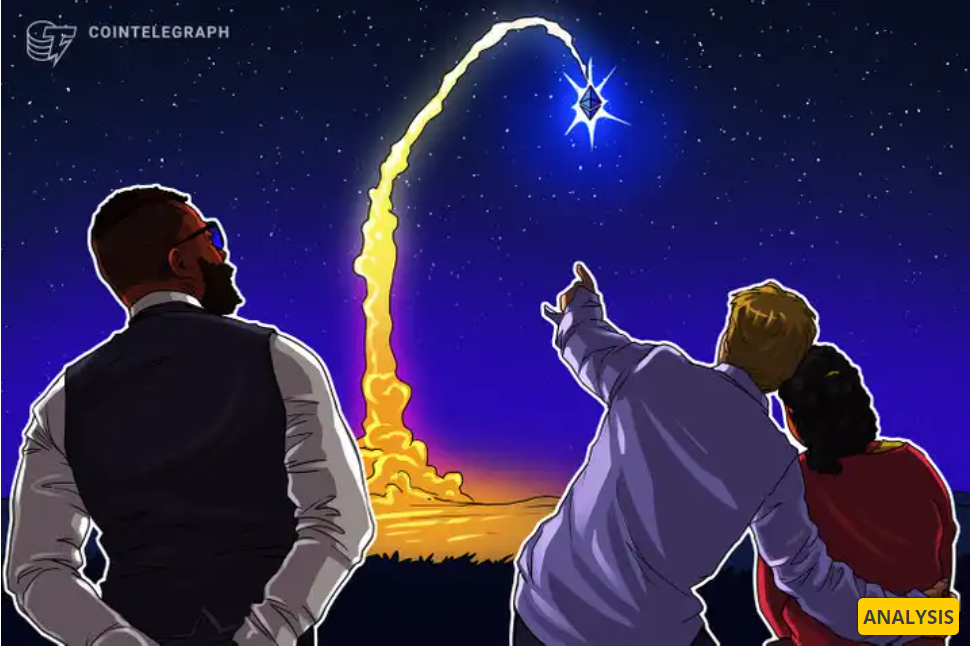
▲圖片標題(來源:cointelegraph)
The Ethereum community has been hard at work over the past few years, laying the foundation for its shift away from its current proof-of-work (PoW) algorithm which has formed the backbone of the blockchain’s operation up until today.
Ethereum’s switch to its proof-of-stake- (PoS-) powered Ethereum 2.0 chain is edging closer to reality, with recent updates to its blockchain resulting in the issuance of Ether (ETH) becoming deflationary.
Recent upgrades have resulted in deflationary issuance of ETH, where the burning of a portion of transaction fees has surpassed the issuance of new ETH through mining. Some in the industry didn’t expect this to happen before the network upgrades to Ethereum 2 (Eth2). It’s an important factor that is envisaged to drive the value of the underlying cryptocurrency upward in the months and years to come.
The influence of this earlier-than-expected shift to the deflationary issuance of ETH cannot be understated in terms of its effects on the value of ETH. Furthermore, industry participants believe this deflation is to increase once the network fully transitions to Eth2, down more than 10 times from its current issuance of 2 ETH per block mined.
Recent developments
Late last year, the foundation was laid for the transition to Eth2 as the proof-of-stake Beacon Chain went live, allowing users to stake Ethereum in order to become validators. This would essentially replace the role of current miners that use physical hardware to validate transactions, add new blocks and generally maintain the network.
As of November 17, 2021, there are over 260,000 validators that have staked the minimum 32 ETH needed to become a validator on the chain. At the time of writing, the current amount of Ethereum tokens staked sits at 8,327,638 ETH — valued at around $34.1 billion.
The value of Ethereum has been on a steady uptrend in 2021 and has hit new highs driven by a variety of factors this year, including the exploding popularity of the decentralized finance (DeFi) space of which a large portion operates on the Ethereum blockchain.
The most anticipated upgrade of 2021 was the London hard fork that introduced a handful of Ethereum Improvement Proposals (EIPs). One particular proposal, EIP-1559, was a point of contention due to the change of fee structures earned by miners and paid by users.
A sore point was the built-in ETH burn mechanism that destroys a portion of Ether used to pay a transaction fee. This irked Ethereum miners before the upgrade, given that transaction fees are a driving factor that incentivizes miners to maintain the network.
Focus now squarely on ‘The Merge’
The roadmap toward Eth2 has one more minor upgrade scheduled in 2021. Arrow Glacier is composed of the solitary EIP-4345, which changes the parameters of what is known as Ethereum’s Ice Age Difficulty Bomb.
The Difficulty Bomb is the name for the planned increasing difficulty level for miners in the current PoW Ethereum mainnet. When the Bomb goes live, the Ethereum network’s mining difficulty will increase exponentially at a certain threshold and will serve as one of the driving factors to incentivize the overall Ethereum network to participate in the merge to Eth2.
Beiko said that the main focus for the wider Ethereum development community is now exclusively on ‘The Merge’, signaling the start of the final chapter in the blockchain’s evolution to PoS consensus.
What to expect when Eth2 becomes a reality
While the exact date of ‘The Merge’ is not yet set in stone, both Beiko and Edgington highlighted the fact that Ethereum developers are now solely focused on the final steps towards Eth2.
Nevertheless, many cryptocurrency users and enthusiasts are asking the same question. What can happen when Eth2 becomes a reality? Edgington gave some insights into how the network will operate in conjunction with various layer-two solutions providing improvements to scalability:
“The move to proof-of-stake will not immediately provide any significant extra throughput to the Ethereum chain, so I don't expect it to have a measurable effect on gas prices. The scalability strategy in Ethereum now revolves around layer-two solutions like the various roll-ups that are currently being deployed. Once The Merge is done, we will focus on providing data shards within the Ethereum protocol that will allow roll-ups to scale massively.”
Edginton also noted that issuance of Ether will drop by 2 ETH per block post-merge as a result of the removal of the mining block reward, while EIP-1559 will continue to burn Ether as it does today: “As a result, it is very likely that the total supply of Ether will shrink for the foreseeable future.”
Viktor Bunin, protocol specialist at Coinbase, highlighted the importance of the London hard fork earlier this year and its widely debated EIP-1559. The mechanisms set in motion by the upgrade give some idea of how the value of ETH will change as the deflationary mechanism gathers momentum, telling Cointelegraph:
“Since launch, EIP-1559 has reduced net issuance on Ethereum by 66%. If the merge were live today, net ETH emission would actually be negative, making the network deflationary. The key bit around EIP-1559 and running validators are making ETH, the asset, more useful. Whereas before, ETH was only indirectly capturing the upside generated on Ethereum, having direct measurable metrics will be useful in helping industry participants understand the value and utility of holding and using ETH.”
These sentiments were echoed by Coinbase software engineer Yuga Cohler, who delved into the numbers to give a data-driven overview of the impact of EIP-1559 to date and how this will continue when The Merge finally takes place: “Total miner revenues in dollar terms have actually increased 33% despite this burn. As validators replace miners and more ETH is staked — and therefore, at least temporarily, locked up — to secure the network, the greater scarcity of ETH will be a part of its value proposition.”
轉貼自: Cointelegraph
若喜歡本文,請關注我們的臉書 Please Like our Facebook Page: Big Data In Finance


留下你的回應
以訪客張貼回應